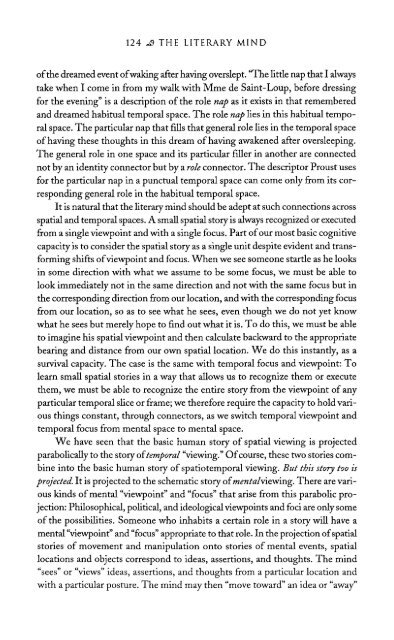The Literary Mind.pdf
The Literary Mind.pdf
The Literary Mind.pdf
You also want an ePaper? Increase the reach of your titles
YUMPU automatically turns print PDFs into web optimized ePapers that Google loves.
124 THE LITERARY MIND<br />
of the dreamed event of waking after having overslept. "<strong>The</strong> little nap that I always<br />
take when I come in from my walk with Mme de Saint-Loup, before dressing<br />
for the evening" is a description of the role nap as it exists in that remembered<br />
and dreamed habitual temporal space. <strong>The</strong> role nap lies in this habitual temporal<br />
space. <strong>The</strong> particular nap that fills that general role lies in the temporal space<br />
of having these thoughts in this dream of having awakened after oversleeping.<br />
<strong>The</strong> general role in one space and its particular filler in another are connected<br />
not by an identity connector but by a role connector. <strong>The</strong> descriptor Proust uses<br />
for the particular nap in a punctual temporal space can come only from its corresponding<br />
general role in the habitual temporal space.<br />
It is natural that the literary mind should be adept at such connections across<br />
spatial and temporal spaces. A small spatial story is always recognized or executed<br />
from a single viewpoint and with a single focus. Part of our most basic cognitive<br />
capacity is to consider the spatial story as a single unit despite evident and transforming<br />
shifts of viewpoint and focus. When we see someone startle as he looks<br />
in some direction with what we assume to be some focus, we must be able to<br />
look immediately not in the same direction and not with the same focus but in<br />
the corresponding direction from our location, and with the corresponding focus<br />
from our location, so as to see what he sees, even though we do not yet know<br />
what he sees but merely hope to find out what it is. To do this, we must be able<br />
to imagine his spatial viewpoint and then calculate backward to the appropriate<br />
bearing and distance from our own spatial location. We do this instantly, as a<br />
survival capacity. <strong>The</strong> case is the same with temporal focus and viewpoint: To<br />
learn small spatial stories in a way that allows us to recognize them or execute<br />
them, we must be able to recognize the entire story from the viewpoint of any<br />
particular temporal slice or frame; we therefore require the capacity to hold various<br />
things constant, through connectors, as we switch temporal viewpoint and<br />
temporal focus from mental space to mental space.<br />
We have seen that the basic human story of spatial viewing is projected<br />
parabolically to the story of temporal "viewing." Of course, these two stories combine<br />
into the basic human story of spatiotemporal viewing. But this story too is<br />
projected. It is projected to the schematic story of mental viewing. <strong>The</strong>re are various<br />
kinds of mental "viewpoint" and "focus" that arise from this parabolic projection:<br />
Philosophical, political, and ideological viewpoints and foci are only some<br />
of the possibilities. Someone who inhabits a certain role in a story will have a<br />
mental "viewpoint" and "focus" appropriate to that role. In the projection of spatial<br />
stories of movement and manipulation onto stories of mental events, spatial<br />
locations and objects correspond to ideas, assertions, and thoughts. <strong>The</strong> mind<br />
"sees" or "views" ideas, assertions, and thoughts from a particular location and<br />
with a particular posture. <strong>The</strong> mind may then "move toward" an idea or "away"















